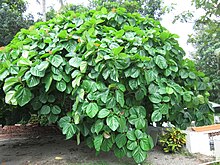Ficus auriculata
| Ficus auriculata | |
|---|---|

| |
| Scientific classification | |
| Kingdom: | |
| (unranked): | |
| (unranked): | |
| (unranked): | |
| Order: | |
| Family: | |
| Genus: | |
| Species: | F. auriculata
|
| Binomial name | |
| Ficus auriculata | |
Ficus auriculata (Roxburgh fig) is a type of fig tree seen all over Asia[1] noted for its big and round leaves. This is used as fodder in Nepal. It is least resistant to fire, but likes good sunlight.[2] Ceratosolen emarginatus is the insect that helps to pollinate this plant.[3][4]
This plant is a small tree of 5–10 m high with numerous bristle-covered branches. The leaves are big and round, and are up to 44 cm long and 45 cm wide, with cordate or rounded base, acute apex, and 5–7 main veins from the leaf base. Its petioles are up to 15 cm long, and it has stipules of about 2.5 cm long. The plant has oblate syconium that are up to 4 cm wide, covered with yellow pubescence, and emerge from the foot of the trees or from old branches.[5]
The fresh fruit of this plant are consumed as food, and have diuretic, laxative and digestive regulating properties.[5]
Photo gallery
-
the fruit of the plant
-
leaf of elephant ear fig
-
fruit
References
- ^ http://www.efloras.org/florataxon.aspx?flora_id=2&taxon_id=200006348
- ^ http://www.forestrynepal.org/resources/trees/ficus-auriculata
- ^ http://www.insect.org.cn/EN/abstract/abstract13628.shtml
- ^ http://www.figweb.org/Ficus/Subgenus_Sycomorus/Section_Sycomorus/Subsection_Neomorphe/Ficus_auriculata.htm
- ^ a b Tanaka, Yoshitaka; Van Ke, Nguyen (2007). Edible Wild Plants of Vietnam: The Bountiful Garden. Thailand: Orchid Press. p. 96. ISBN 9745240893.
External links
 Media related to Ficus auriculata at Wikimedia Commons
Media related to Ficus auriculata at Wikimedia Commons



